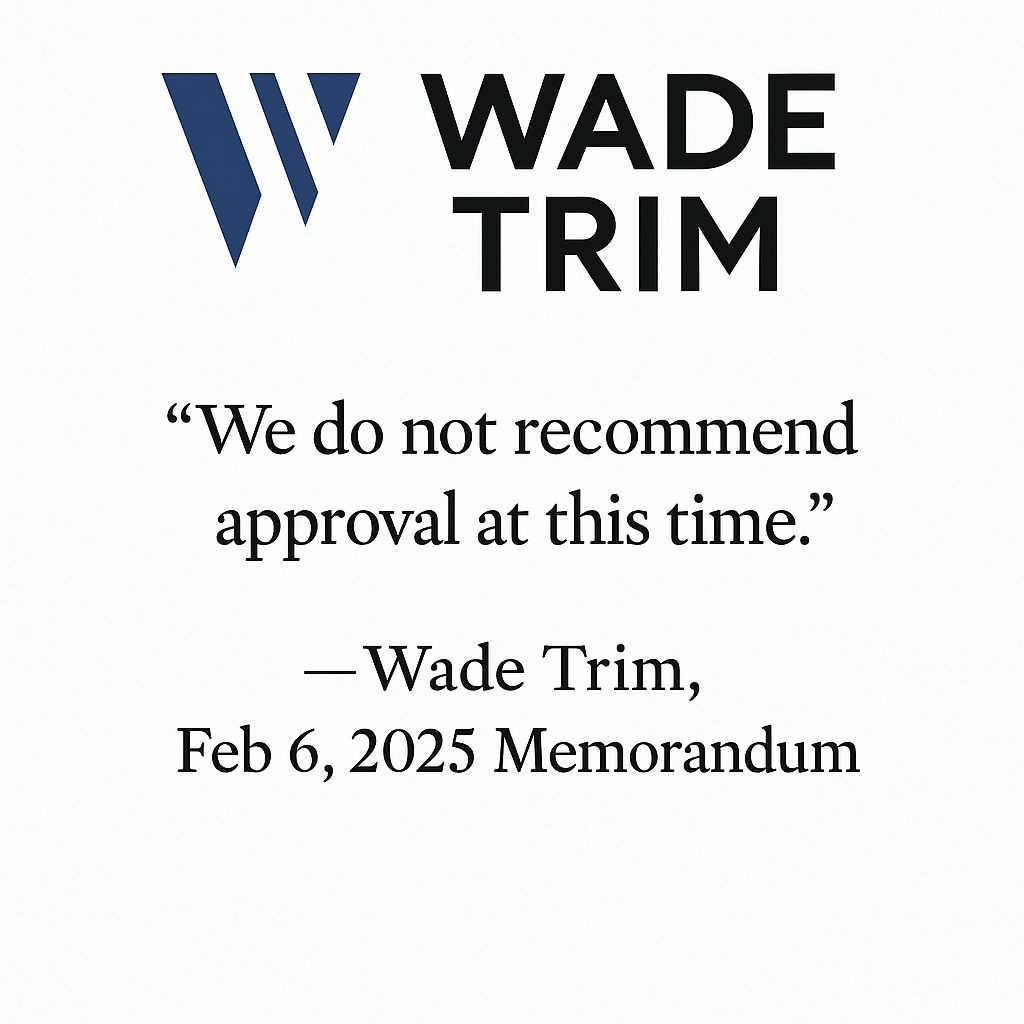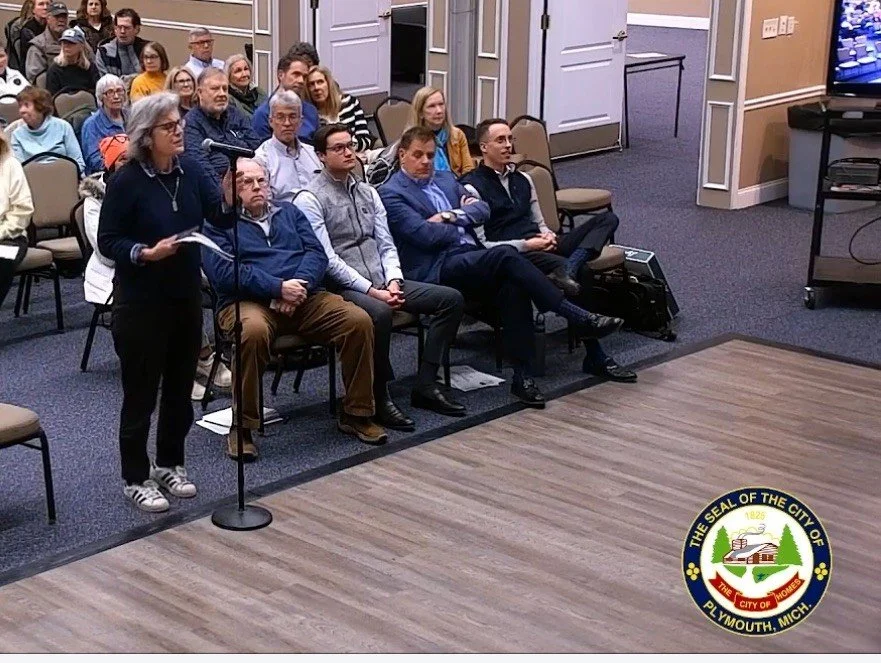
📏 Zoning and Deviations Requested:
The site is zoned R-1 (Single-Family Residential), but the PUD would allow:
Increased density (from 7 allowed under current zoning to 20 proposed).
Reduction in required church lot size, setbacks, and road frontage.
Townhomes, which are not permitted under strict R-1 zoning.
Reduced distance between buildings and side/front yard setbacks for the church.
20 condo units
3 detached units along Ann Arbor Trail
17 attached townhomes in the interior of the site (2.5 stories tall)
New Church Building
Build a new 3400 square f00t Christian Science Church to remain on-site.
🏗️ Champion Development withdraws from The Christian Science Church Project! Please stay tuned for further updates.
Champion Development Group — a non-local developer — is seeking special rezoning approval (a PUD) to dramatically alter the character of the property at 1100 W. Ann Arbor Trail, known as the Christian Science Church which is currently zoned for single-family homes (R-1).
🗺️Inconsistency with the City Master Plan
Issue: The site is designated as "Mixed Use: Low Density", favoring single-family character and two-story maximum height. The proposed 17 attached, 2.5-story townhomes deviate from this vision.
Concern: The project’s scale, height, and multi-family form may disrupt the intended transition between downtown and surrounding neighborhoods, clashing with nearby single-family homes along Ann Arbor Trail.
📈 Density Concerns
Issue: 20 units are proposed where only 7 single-family lots would be allowed under current R-1 zoning. Density could exceed RM-2 standards by up to 12% (83 rooms vs. 74 allowed).
Concern: This increase could burden infrastructure, reduce greenspace, and compromise the low-density character of the neighborhood.
🚦 Traffic & Safety Concerns
Issue: The developer’s Trip Generation Study claims minimal impact but lacks a comprehensive traffic study, as requested by the Planning Commission.
Concern: Without reliable data, the project's impact on Ann Arbor Trail and adjacent streets remains uncertain—particularly given its transitional location near downtown.
🧱 Zoning Deviations
Major deviations include:
Church front setback: 42 ft (required: 50 ft)
Church side setback: 10 ft (required: 30 ft)
Church lot size: 0.72 acres (required: 3 acres)
Townhome spacing: 31 ft rear-to-rear (required: 70 ft) and others
Concern: These deviations could set a precedent for bypassing zoning ordinances, reduce resident privacy, and diminish open space.
🟡 Inadequate Public Benefits
Issue: Claimed benefits (trail, pocket park, shared parking) are under-detailed or speculative.
Example: The pocket park resembles basic landscaping; shared parking lacks agreements; creek work lacks a maintenance plan.
Concern: The PUD process requires meaningful public benefits to justify deviations. Without concrete deliverables, these promises feel insufficient.
🌳 Environmental & Floodplain Risks
Issue:
Townhomes are 8–22 feet from Tonquish Creek’s top of bank.
Building elevations are 2–3 feet lower than existing grade.
EGLE permit not secured; property line discrepancies exist for restoration work.
Concern: Project could exacerbate flooding, erosion, or damage the creek ecosystem. Prior flood events (Aug 2023, Apr 2025) highlight the risks.
🔨 Phased Construction & Timing Uncertainty
Issue: Construction will occur in phases, beginning with infrastructure, the church, the 3 Ann Arbor Trail homes, and one townhome building. Remaining buildings will follow based on sales activity.
Concern: Phasing could result in a partially completed site for an unknown period, with:
Incomplete restoration or amenities.
Ongoing construction disruption.
Delayed public benefits.
Potential developer exit before full completion.
Additional Risk: The church may be built early but surrounded by active construction, impacting usability and safety.
🧾 Unclear Ownership & Project Control
Issue: The project lacks a confirmed single responsible party, and the Master Deed excludes the church.
Concern: Without unified ownership/control, construction, operations, and long-term maintenance could become disjointed or incomplete.
🏗️ Architectural Uncertainty
Issue: Design of the three Ann Arbor Trail single-family homes is postponed for “buyer input.”
Concern: This contradicts the PUD’s requirement for a specific site plan and opens the door to inappropriate or out-of-character design.
💧 Stormwater & Infrastructure Concerns
Issue: No rain gardens or infiltration basins are included. City Engineer has not confirmed sewer/water system capacity.
Concern: Inadequate stormwater planning could increase runoff and flood risk; infrastructure strain could impact existing residents.
🅿️ Parking & Loading Deficiencies
Issue:
Visitor parking is limited.
Shared parking agreements are not finalized or included in the Master Deed.
No loading/unloading zone is designated for the church’s reading room.
Concern: This may lead to overflow parking and operational issues for both residents and the church.
💵 Community Fit & Economic Impact
Issue: The development’s design and density may not “fit” the single-family neighborhood.
Concern: Could negatively affect property values, deter buyers, and weaken long-term neighborhood identity.
❗ Incomplete or Missing Plan Details
Gaps include:
No floor plans or size ranges for 20-foot-wide townhomes.
No delivery logistics plan for the church.
No documentation of a Cross Access Use Agreement.
No confirmed maintenance plan for creek restoration.
Concern: These omissions raise doubts about implementation, compliance, and accountability.
✅ Summary
The Champion PUD proposal raises substantial concerns regarding zoning compliance, environmental impact, infrastructure readiness, and long-term viability. The phased construction model, combined with unresolved ownership and incomplete designs, further elevates the risk of unfinished development, ongoing disruption, and diminished neighborhood harmony. Without enforceable public benefits and clearer commitments, this project does not sufficiently justify the extensive zoning deviations requested.
🔎 Integrity & Transparency Concerns
🧭 Questionable Shift in Voting
How did a "No" vote get reversed to a "Yes" vote ? This raises concerns about process and impartiality.
🕒 Time: 04:11:40
"No, that's five. No. Five. Five what? Five. No. Four. Yes. 1, 2, 3, 4, 5. Scott voted yes."🕒 Time: 04:12:18
"Okay. So now, um, let's, if we... Discuss, discuss. So I think that, you know, I'm moving towards approval, right?"
Former Chair of Planning Commission comments - “I felt pressure from the Mayor twice”
🏛️ Apparent Bias in Appointments
All three Planning Commission members recently appointed by the Mayor voted in favor of the development.
One of the appointees had previously spoken in support of the project as a resident before her appointment.
🤐 Undisclosed Speaker
The developer’s wife spoke during public comment without identifying her connection to the project.
Our neighbors speak out
“Small-town America is under assault by care-less developers who just want to maximize density to maximize their profits.”
— Bob Bake, 1303 Park Place - Longtime Plymouth realtor, now retired
“The Champion PUD does not meet the requirements in the PUD ordinance. It fails to provide a true public benefit.”
- Karen Sisolak, former Plymouth City Planning Commission Chair and candidate for the City Commission,
Sisolak writes about the PUD on her blog: https://48170.info
In a public comment addressing the proposed Champion Brookside development in Plymouth, Tom Doran highlights the overlooked impact of clustering over 140 residents and more than 100 vehicles into a small, already-congested area. His analysis raises serious concerns about traffic, pedestrian safety, and the vulnerability of nearby senior residents — urging city officials to consider the real, measurable consequences of high-density development.
“How can that many vehicles and people not produce a significant traffic and safety impact? The big-picture math supports this conclusion.”
— Tom Doran, Fellow, Engineering Society of Detroit - 1191 Sheridan Street
“EGLE (Michigan Department of Environment, Great Lakes, and Energy ) will never allow Champion to discharge stormwater directly into the Tonquish creek. Champion has to slow the rate of stormwater discharging from their site into the city underground storm water system and a detention system is the only way to accomplish that. Champion cannot turn a fundamental requirement into a public benefit.”
Scott Silvers - Former City Planning Commissioner six years - Candidate for City Commission
"I hope that you consider to deny this very bad idea. Traffic and parking will be a mess, and the church's financial gain is unclear."
— Denise Varner, 1428 Sheridan
"I personally would recommend that you vote on it and deny it. This is the fourth time, and it's more dangerous than the last one."”
— Ron Picard, 1373 Sheridan - Candidate for City Commission
“As a former principal at Bird school, approving this rezoning request will further endanger the lives of our students. Traffic conditions and congestion are already problematic.”
— Sam Barresi, 533 Herald Street
Heatmap - Shows areas of opposition to the proposed development.
All colors indicate opposition!
Protecting Our Heritage
This development threatens Plymouth’s natural beauty:
Removal of many mature trees along Tonquish Creek
Destruction of a 175 plus-year-old Heritage Walnut Tree.
Disruption of local wildlife and the creek’s native state.
How You Can Help
Join us in protecting Plymouth’s character and safety:
Attend planning commission meetings
Sign petitions opposing the PUD
Contact local officials
Share this site on social media.
Inquiries
Questions
Send your info opposing the PUD








